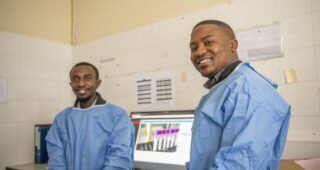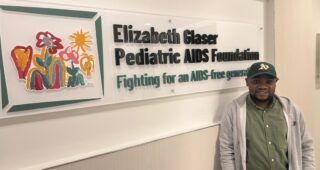Global Female Condom Day: Why Reproductive Health and HIV Are Linked

Sept 16 is Global Female Condom Day, an opportunity to educate the world and empower women to take control of their reproductive health. We sat down with Florence Ngobeni-Allen—a peer counselor living with HIV and the mother of two healthy sons—to hear her thoughts on reproductive health as it pertains to HIV.
In your role as an Elizabeth Glaser Pediatric AIDS Foundation (EGPAF) ambassador and peer counselor, how do you educate women about reproductive health and voluntary family planning?
According to the World Health Organization (WHO), 222 million women in low-resource countries want to delay or avoid pregnancy, but they do not have access to effective contraception.
In my country, South Africa, 60 percent of the births are unplanned according to a 2011 study—which shows that we still have a long way to go in terms of providing access and educating women about their family planning options. In my travels around Africa and even in the United States, I find that women are too often poorly informed about ways in which they could take charge of their reproductive health.
Many young women lack basic knowledge about pregnancy and sexually transmitted infections like HIV. And even women with a solid understanding of reproductive health may not know about different types of contraceptives such as female condoms.
I educate women during public talks at workplaces, schools, universities, government meetings, and conferences. Sometimes I simply inform them about their choices. Other times I listen as they explain their situations, and I offer encouragement.
Women have many roles, and I try to help them see their roles and responsibilities as individuals, community volunteers, health care workers, or students.
Why do you think it’s important to link HIV services and voluntary family planning services?
Family planning is especially important for a woman living with HIV because she needs to control the spacing of births in her family so that she can focus on herself and her child during pregnancy and breastfeeding.
It is also important to link the two services because anyone who is sexually active risks contracting HIV, especially if neither partner is using a condom. Combining family planning and HIV services helps normalize HIV services and encourages people to test for HIV and other sexual transmitted infections on a regular basis.
In addition, reducing the number of unintended pregnancies reduces the number of infants exposed to HIV, and consequently, the number of babies infected with HIV.
What is the biggest barrier that prevents women from accessing reproductive health or voluntary family planning services in sub-Saharan Africa?
Often, if a woman does not access reproductive health services, it is because she is embarrassed that she might be judged for having sex—especially if she is HIV positive or unemployed. Women often fear the reactions and attitudes of health care workers.
Adolescent girls, in particular, may find it hard to access reproductive health services because of stigma related to their young age, unmarried status, or unemployment.
So part of my work as a peer counselor is assuring women that health care workers are professionals who care foremost about health.
Another barrier is the distance that a woman must travel to access the family planning services. It is hard for women who recently given birth to take a child for immunization and then go for family planning on a different date and at a different facility.
This is one of the reasons that EGPAF is working to expand access and integrate services—so that women can access comprehensive health services at nearby clinics—meeting many health and family planning needs at one time.
How does integrating these services particularly help women living with HIV who want to have children?
It will help them understand that they should seek the advice of health care workers if they want to conceive. Counseling offered before conception educates women about the ways that she can prevent her unborn child from contracting HIV.
Integration of services also helps combat HIV stigma by normalizing HIV services with the rest of sexual and reproductive services. And it can encourage her to disclose her HIV status to her partner.
What else can the global community do to combat stigma and encourage women to seek out voluntary family planning and reproductive health services?
In general, the global community needs to continue its fight for the rights of women to access health care, education, and employment opportunities. We also need to advocate for the right of women to live without the threat of violence. These factors are tremendously important in empowering women to take care of their reproductive health.
How do you think improving women’s access to voluntary family planning and reproductive health services will help us achieve an AIDS-free future?
Women are busy people with a lot of responsibilities. Transmission of HIV from mother to child and between partners will dramatically decrease if services for women’s health—including reproductive health and HIV services—are easily accessible in every neighborhood, town, and village across the world.
Florence Ngobeni-Allen
General



